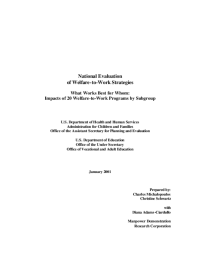What Works Best for Whom
Impacts of 20 Welfare-to-Work Programs by Subgroup
In 1996, Congress radically transformed the nation’s cash assistance welfare program when it passed the Personal Responsibility and Work Opportunity Reconciliation Act (PRWORA). The legislation replaced the 60-year-old Aid to Families with Dependent Children (AFDC) entitlement program with Temporary Assistance for Needy Families (TANF), a funding mechanism that provides states with block grants and considerable flexibility in designing their welfare programs. In addition to making other changes, many states responded by expanding their employment and training programs or changing the focus of their existing programs. A number of states replaced voluntary welfare-to-work programs that emphasized education and training with mandatory programs that stressed quick employment.
While many aspects of the 1996 legislation and the state policies that followed were untested, the use of mandatory welfare-to-work programs was not. During the ten years prior to PRWORA, large-scale rigorous studies of welfare-to-work programs were launched in many states and counties. This report investigates results from 20 of these programs to determine who has benefited from welfare-to-work programs (and who has not) and whether some practices appear more effective than others at increasing the employment and earnings of single-parent welfare recipients.
The programs studied in this report share two key characteristics. They all required some portion of the welfare caseload to participate in a welfare-to-work program or risk losing some or all of their welfare benefits through sanctions. And they were all studied by the MDRC using a rigorous experimental research design in which individuals were assigned at random either to a program group, which was required to participate in an employment or training program, or to a control group, which did not have access to the program.






